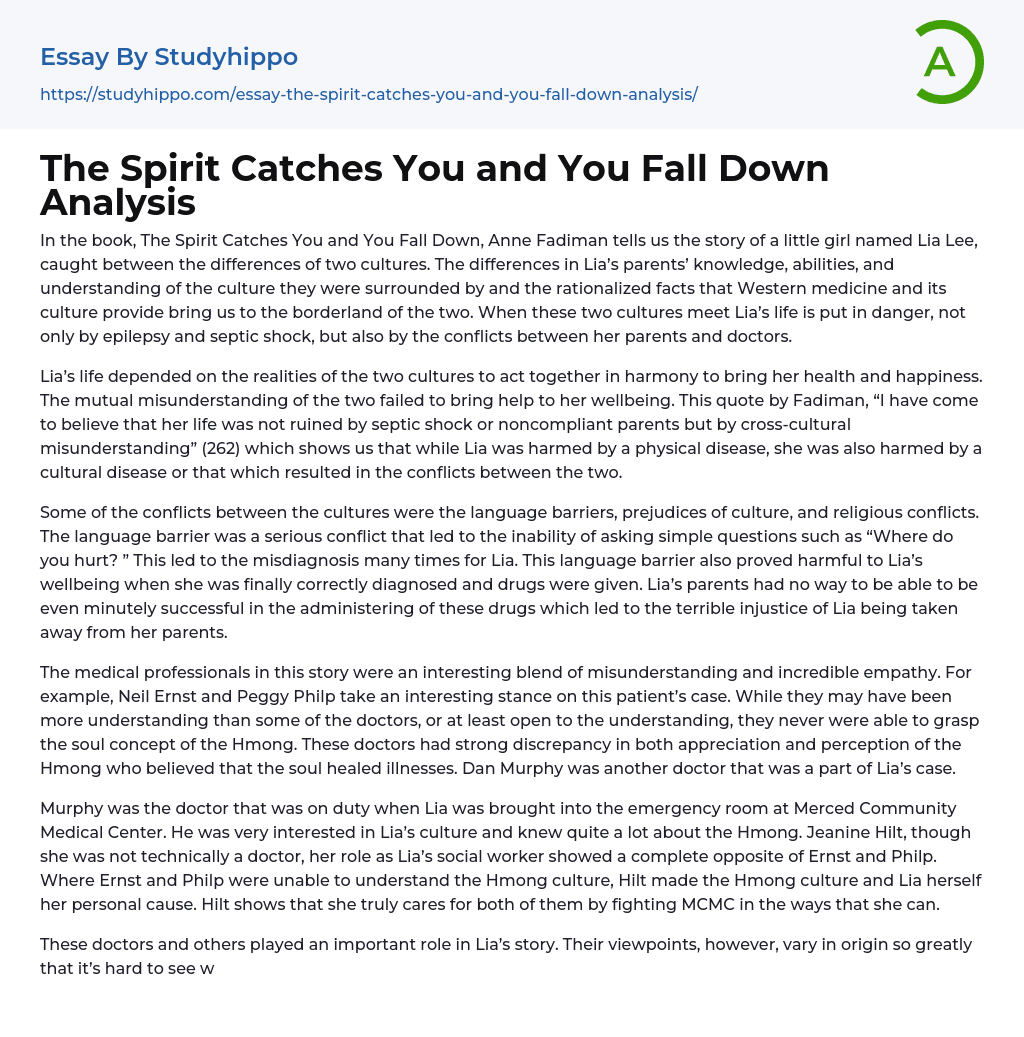

The Spirit Catches You and You Fall Down Analysis Essay Example
The experiences of Lia Lee, a young girl who becomes a symbol of cultural clash, are chronicled by Anne Fadiman in The Spirit Catches You and You Fall Down. Lia's parents' limited knowledge and understanding of the culture they find themselves in contrasts with the logical framework of Western medicine. This creates a transitional space between the two worlds where cultures intersect. In this intersection, Lia's life is not only at risk due to her medical conditions of epilepsy and septic shock but also exacerbates conflicts between her parents and healthcare providers.
Lia's well-being relied on the two cultures working together harmoniously to ensure her health and happiness. Unfortunately, the lack of understanding between the two cultures hindered her well-being. Fadiman's quote, "I have come to believe that her life was not ruined by septic shock or noncompliant parents but by cross-cu
...ltural misunderstanding" (262), highlights that Lia suffered not only from a physical illness but also from a cultural divide, which led to conflicts between the two.
Some conflicts between cultures included language barriers, cultural prejudices, and religious conflicts. The language barrier was a significant issue as it prevented simple communication, such as asking about physical pain. As a result, Lia was often misdiagnosed. This language barrier also had detrimental effects on Lia's wellbeing when she was correctly diagnosed and given medication. Without the ability to understand and administer the drugs, Lia's parents were unjustly separated from her.
The medical professionals featured in this story displayed a unique combination of misunderstanding and remarkable empathy. Neil Ernst and Peggy Philp, for instance, held an intriguing perspective on the patient's situation. Despite
being more understanding than other doctors and being open to understanding, they still couldn't fully comprehend the Hmong's belief in the healing power of the soul. Another doctor involved in Lia's case was Dan Murphy.
Murphy, the doctor on duty at Merced Community Medical Center, showed a keen interest in Lia's culture and had extensive knowledge about the Hmong. In contrast, Jeanine Hilt, although not officially a doctor, acted as Lia's social worker and demonstrated a starkly different approach from Ernst and Philp. While Ernst and Philp struggled to comprehend the Hmong culture, Hilt made it her mission to understand the culture and advocate for Lia. Hilt's dedication is evident through her efforts to fight against the MCMC in any way she could, displaying genuine care for both Lia and the Hmong culture.
The doctors in Lia's story had varying viewpoints, making it challenging to determine who would have provided better care for her. Consequently, each doctor's actions evoked different reactions from readers. The choices and decisions made in the book elicited multiple responses from me as well. One notable choice was when Dr. Ernst grew frustrated with the Lees and reported them for child abuse because they were unable to properly give Lia her medication.
Moreover, disregarding the Lees' concerns for Lia's well-being would have been more beneficial if her parents understood their cherished daughter's situation. Dr. Ernst's decision led to Lia being separated from her caring parents, which made me feel angry and frustrated. The doctor failed to consider both perspectives and find the best solution for Lia. Reflecting on this, it saddens and greatly concerns me about our healthcare
system as he could have easily prevented Lia from being taken away from her home.
The Lee family's decision to only bring in Lia in urgent situations is relatable to me because my own family also tends to avoid doctors and hospitals unless absolutely necessary. Instead, we prefer homeopathic methods of healing. However, it is challenging to compare something like a flu to epilepsy. The Hmong people have a completely different belief about the cause of sickness compared to Western medicine doctors, which contributes to all of Lia's problems. According to Hmong beliefs, sickness is caused by a malevolent spirit that takes away a person's soul. The only way to bring back the lost soul is through a ritual performed by a shaman.
The story of Lia demonstrates the conflicts that arise from the disparities between Western medicine, which is considered scientific and specialized, and the strong beliefs of Lia's parents who sought to protect her. These disagreements worsened Lia's medical issues, emphasizing the theme of difference in the narrative.
In my opinion, the book did not provide the entertainment or inspiration I anticipated. Lia's story evoked sadness and raised questions about America's medical system and our perception of other cultures. The unresolved conflicts between the opposing sides deepened my cynicism and left me with a negative impression. While I do not suggest this book to others, I acknowledge its potential value for medical students or individuals interested in healthcare who wish to gain insight into this aspect.
- Hospital essays
- Physician essays
- Health Care Provider essays
- Universal Health Care essays
- Readmission essays
- Addiction essays
- Anatomy and Physiology essays
- Biodegradation essays
- Cancer essays
- Dental Care essays
- Disability essays
- Disease essays
- Disorders essays
- Health Care essays
- Infectious Disease essays
- Inquiry essays
- Intelligence Quotient essays
- Lung Cancer essays
- Medicine essays
- Neurology essays
- Nutrition essays
- Olfaction essays
- Physical Exercise essays
- Public Health essays
- Sex essays
- Women's Health essays
- World health organization essays



